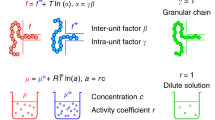Abstract
Molecular dynamics simulation were employed to investigate the effect of changing the potential energies describing primary and secondary bonds on the Young’s modulus of a polymer. The energies were changed by arbitrarily modifying the parameters of the potential energy model function. The parameters influence the structure of the polymer and its global energy, eventually causing changes to the Young’s modulus. The van der Waals energy describing secondary bonds gives the most significant contribution to the changes. Increasing the energy increases the density and Young’s modulus. The trends are in agreement with experimental data.






Similar content being viewed by others
Data availability
Data available on request from the authors.
References
Rackley FA, Turner HS, Wall WF, Haward RN (1974) Preparation of crosslinked polymers with increased modulus by high-pressure polymerization. J Polym Sci Polym Phys 12:1355–1370
Phan AC, Tang M-L, Jean-François Nguyen N, Ruse D, Sadoun M (2014) High temperature high-pressure polymerized urethane dimethacrylate—Mechanical properties and monomer release. Dent Mater 30(3):350–356
Nguyen J-F, Véronique Migonney N, Ruse D, Sadoun M (2012) Resin composite blocks via high-pressure high-temperature polymerization. Dent Mater 28(5):529–534
Holliday L, White J (1971) The stiffness of polymers in relation to their structure. Pure Appl Chem 26:545
Seitz JT (1993) The estimation of mechanical properties of polymers from molecular structure. J Appl Polym Sci 49:1331–1351
Fedors R (1974) Method for Estimating Both the Solubility Parameters and Molar Volumes of liquids. Polym Eng Sci 14:472
Brown D, Clarke JHR (1991) Molecular dynamics simulation of an amorphous polymer under tension: I. Phenomenology. Macromolecules 24(8):2075–2082
Yang L, Srolovitz DJ, Yee AF (1997) Extended ensemble molecular dynamics method for constant strain rate uniaxial deformation of polymer systems. J Chem Phys 107:4396
Fortunelli A, Geloni C (2004) Simulation of the plastic behavior of amorphous glassy bis-phenol-A-polycarbonate. J Chem Phys 121(10):4941–4950
Lyulin AV, Li J (2006) Atomistic Simulation of Bulk Mechanics and Local Dynamics of Amorphous Polymers. Macromolecular Symposia 237(1):108–118
Capaldi F, Boyce MC, Rutledge GC (2004) Molecular response of a glassy polymer to active deformation. Polymer 45:1391–1399
Hossain D, Tschopp M, Ward D, Bouvard J, Wang P, Horstemeyer M (2010) Molecular dynamics simulations of deformation mechanisms of amorphous polyethylene. Polymer 51:6071–6083
Sahputra IH, Echtermeyer A (2013) Effects of temperature and strain rate on the deformation of amorphous polyethylene: a comparison between molecular dynamics simulations and experimental results. Model Simul Mater Sci Eng 21:065016
Sahputra IH and Echtermeyer AT, (2014) "Creep-fatigue relationship in polymer: a molecular dynamics simulations approach," Macromolecular Theory and Simulations
Sahputra IH, Alexiadis A, Adams MJ (2018a) Temperature and configurational effects on the Young’s modulus of poly (methyl methacrylate): a molecular dynamics study comparing the DREIDING, AMBER and OPLS force fields. Mol Simul 44(9):774–780
Wen-Sheng Xu, Douglas JF, Freed KF (2016) Influence of Cohesive Energy on the Thermodynamic Properties of a Model Glass-Forming Polymer Melt. Macromolecules 49(21):8341–8354
Xu W-S, Douglas JF, Freed KF (2016) Influence of cohesive energy on relaxation in a model glass-forming polymer melt. Macromolecules 49(21):8355–8370
Sahputra IH and Echtermeyer A, (2013) "Molecular Dynamics Simulation of Polycarbonate Deformation: Effect of Temperature and Strain Rate," in International Conference on Computational Mechanics (CM13), Durham
Mayo SL, Olafson BD (1990) DREIDING: a generic force field for molecular simulations. J Phys Chem 94(26):8897–8909
Plimpton S (1995) Fast parallel algorithms for short-range molecular dynamics. J Comput Phys 117(1):1–19
Bicerano J, (2002) Prediction of Polymer Properties, Marcel Dekker
Sahputra IH, Alexiadis A, Adams MJ (2018b) Temperature dependence of the Young’s modulus of polymers calculated using a hybrid molecular mechanics-molecular dynamics method. J Phys: Condens Matter 30(35):355901
Author information
Authors and Affiliations
Corresponding author
Additional information
Publisher’s Note
Springer Nature remains neutral with regard to jurisdictional claims in published maps and institutional affiliations.
Rights and permissions
About this article
Cite this article
Sahputra, I.H., Echtermeyer, A. The effects of the van der Waals potential energy on the Young’s modulus of a polymer: comparison between molecular dynamics simulation and experiment. J Polym Res 28, 47 (2021). https://doi.org/10.1007/s10965-021-02413-4
Received:
Accepted:
Published:
DOI: https://doi.org/10.1007/s10965-021-02413-4




